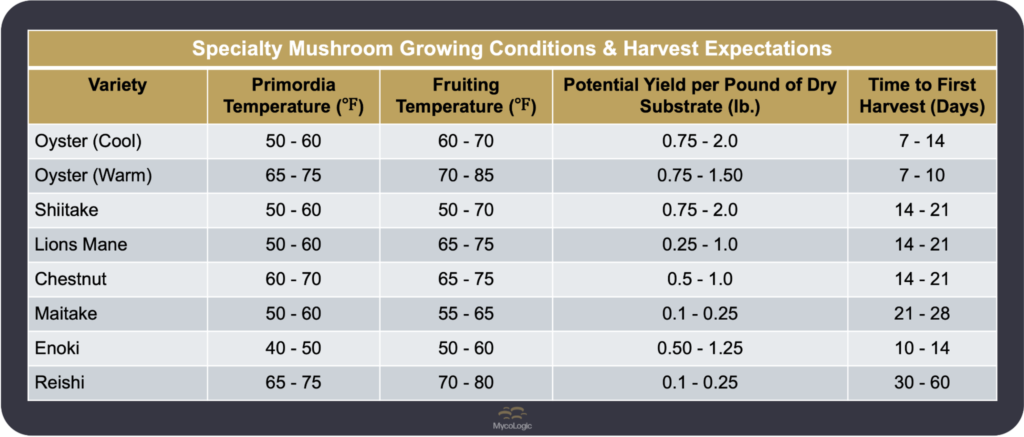Fungi comprise a vast group of organisms with their own distinct lineage in the tree of life, occupying their own branch beside animals and plants. Thus, they have similarities and differences from plants and animals that make them unique. The mushrooms we often think of when discussing fungi are the reproductive structures that form at the end of a complex life cycle of many fungi. For commercial mushroom cultivation, understanding this life cycle is crucial, since there are several critical stages of the cycle where if specific conditions are left uncontrolled, it could result in poor mushroom yield or quality. Below is a brief overview of the three main stages of this cycle: colonization, primordia formation, and mushroom production.
Phase 1: Inoculation & Colonization
Like all life, fungi require nutrients to grow. However, fungi are somewhat unique in their ability to obtain nutrients by secreting enzymes into the environment that degrade organic materials, such as wood, grains, hulls, and other organic materials. This ability has allowed fungi to become some of the major decomposers on Earth, contributing to the vast majority of nutrient recycling in most ecosystems.
The decomposition of materials fungi come into contact with, generally called growth substrates, enables the subsequent growth from their nutrients that are released in the decomposition process, which is known as colonization. The colonization of growth substrates by fungi is initially used to generate biomass in the form of filamentous growth known as hyphae and mycelia, which are microscopic filaments that extend within and around all parts of the substrate prior to the production of mushrooms. This fungal colonization is the same growth that’s commonly seen as a fuzzy mold-like appearance on expired food products.
For the best chance of a successful colonization, mushroom fungi should be the dominant organism growing on the substrate, therefore the substrate needs to first be sterilized (where all microorganisms are killed) or pasteurized (where most microorganisms are killed), typically with high heat and pressure or steam. This ensures the mushroom fungus colonizing the substrate is the most abundant organism and encounters few, if any, competing microorganisms. Think of it like weeding your garden before planting seeds. By reducing the number of foreign plants competing for space and nutrients, you’re giving your seedlings the best chance of survival. Similarly, by providing an environment that supports the highest growth potential for your mushroom fungus, you’re maximizing the amount of growth substrate the fungus can colonize, thereby increasing the maximum potential mushroom yield.
After an initial exposure of the fungus to the substrate, called inoculation, it will grow throughout, often appearing as a bright white mycelial mat coating the visible part of the substrate (Figure 1). During this time, temperature will be one of the main factors influencing the speed at which colonization occurs. This will vary from species to species, but generally fungi will colonize faster at warmer temperatures.

Figure 1. Mushroom mycelia colonizing growth substrate.
Late in the colonization phase, weeks to months after inoculation, the conversion of growth substrate into fungal biomass will slow as nutrients become depleted. At this point, when the fungus is starved of new nutrition, it’s ready to shift to the next growth stage. This is typically the point where pre-colonized substrate blocks are ready to be sold by substrate vendors, since they’ve now reached the point at which mushrooms will form.
Functionally, mushrooms are the reproductive structure of a fungus, producing and releasing spores (analogous to the fruits and seeds of plants). However, spores are dormant single cells that develop an incredibly resilient protective exterior that allows them to withstand extreme adverse conditions, such as a cold, heat, dehydration, radiation, or periods without nutrients. One of the strongest signals for a fungus to shift its metabolism to producing mushrooms that generate these spores is nutrient depletion, or starvation.
Once the growth substrate has been fully-colonized, the fungus is forced to either risk dying if it continues expending energy looking for new sources of nutrition, or divert its energy into producing spores. In nature, these spores would be able to survive in their dormant state for extended periods of time, until conditions became favorable again. By artificially creating these adverse conditions in a controlled manner, we can stimulate mushroom production.
Phase 2: Primordia Formation
The second stage of life cycle is the formation of primordia, or pins, which are microscopic structures that will swell and eventually develop into mushrooms (Figure 2). Primordia will form naturally in response to a number of environmental cues, including, but not limited to, nutrient depletion, reducing carbon dioxide concentration, reducing temperature, and increasing humidity, among other conditions, depending on the mushroom species.

Figure 2. Mushroom primordia (pins) forming on fully-colonized substrate
If primordia formation is halted or negatively impacted, the final mushroom yield can be significantly reduced. Therefore, it is crucial to understand and produce the optimal conditions necessary to promote the formation of healthy primordia. For this reason, many farmers develop indoor mushroom growth chambers to control and regulate these environmental conditions, in order to maximize mushroom yields and health.
Phase 3: Mushroom Production
Following the formation of primordia, if conditions remain favorable, the primordia will develop into mature fruit bodies, or mushrooms (Figure 3). This process can take as little as a few hours to as much as several months, depending on the variety. Environmental conditions may or may not need to be adjusted to promote primordia to develop into mushrooms, but often a slight reduction in humidity can reduce the likelihood of competing microorganisms infecting the newly-forming mushrooms.

Figure 3. Mushroom fruiting bodies forming on fully colonized substrate.
During the fruiting stage, the time to harvest will be based on when the mushroom has sufficiently matured, and is often species-specific. This can also be a preference of the grower, as there can be significant differences between mushrooms that are harvested early and late in the growth cycle. With shiitake mushrooms, for instance, the optimal time to harvest is often right before or immediately after the veil that spans from the stem to the edge of the mushroom cap ruptures. For oyster mushrooms, there is no veil, and the optimal harvest time is often before the cap edges flare upward and large amounts of spores are released.
The harvest time is a choice that is influenced by appearance, size, perishability, spore production, and scheduling. It is recommended to research the varieties being grown and experiment to find the optimal time to harvest. Below, you can find examples of the conditions that commonly-grown mushroom varieties thrive in, their average yields, and time to first harvest (Table 1).

Table 1. Specialty mushroom growing conditions & harvest expectations.
Many mushroom varieties will be capable of producing multiple harvests from the same colonized substrate. The first harvest, or flush, is often the largest, with a diminishing return in each subsequent flush. A farmer has to decide whether the risk of contamination and continued occupation of space in the fruiting room is worth the sometimes meager addition to the total yield. Many farmers will choose to only fruit the first flush before replacing with the next batch of colonized substrate.
Whichever approach you take, it should be evident that mushroom cultivation is a complex process that has many points that can lead to optimization or failure.
MycoLogic’s Autonomous Fruiting Module Systems
At MycoLogic, we take the variability out of the fruiting process with innovative Fruiting Modules that are turnkey, semi-autonomous, controlled environment cultivation systems, along with experienced consultations. Our technology enables precise control of the growing conditions to not only boosts yield but also reduces labor and enhances scalability, making it easier for growers to efficiently meet demand.
Our 40-foot Fruiting Module is designed specifically with mushroom cultivation in mind, controlling temperature, humidity, and CO2 levels within the fruiting room to ensure optimal conditions are met for the cultivation of specialty mushrooms. This is done automatically through our proprietary control system. By partnering with us, farmers can improve production and maximize profit—all with a streamlined, data-driven approach.

Figure 4: Chestnut mushrooms fruiting in our 2nd Generation Fruiting Module (left) and part of the control user interface (right).
The specialty mushroom market is growing as consumers increasingly seek health-conscious and sustainable food options. With demand outpacing supply, those interested in mushroom farming can find their place in this evolving market by embracing innovative technologies. MycoLogic’s controlled environment systems offer practical solutions for scaling production and ensuring consistent yields throughout the year. By exploring these opportunities, anyone can adapt to market trends, enhance profitability, and contribute to a more sustainable food system.

If you’re curious about how MycoLogic can support your farming journey, reach out to us today!